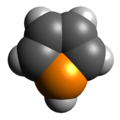| |||
| Names | |||
|---|---|---|---|
| Preferred IUPAC name 1H-Phosphole [1] | |||
| Identifiers | |||
3D model (JSmol) | |||
| 969375 | |||
| ChEBI | |||
| ChemSpider | |||
PubChem CID | |||
CompTox Dashboard (EPA) | |||
| |||
| |||
| Properties | |||
| C4H5P | |||
| Molar mass | 84.058 g·mol−1 | ||
| Related compounds | |||
Related compounds | Pyrrole, bismole, arsole, stibole; phosphorine | ||
Except where otherwise noted, data are given for materials in their standard state (at 25 °C [77 °F], 100 kPa). | |||
Phosphole is the organic compound with the chemical formula C
4H
4PH; it is the phosphorus analog of pyrrole. The term phosphole also refers to substituted derivatives of the parent heterocycle. These compounds are of theoretical interest but also serve as ligands for transition metals and as precursors to more complex organophosphorus compounds.
Contents
Triphosphole, C
2H
3P
3, is a heterocycle with 3 phosphorus atoms.
Pentaphosphole, P
5H, is a cyclic compound with 5 phosphorus atoms.


